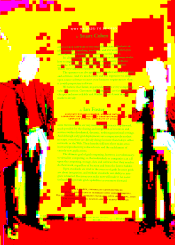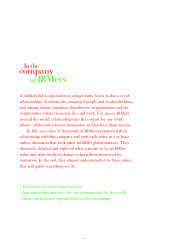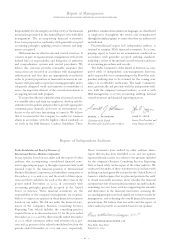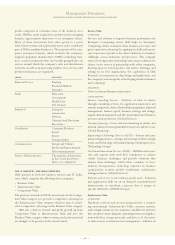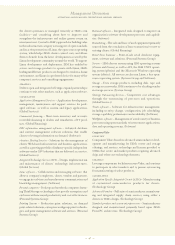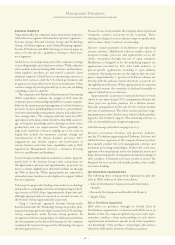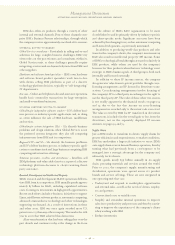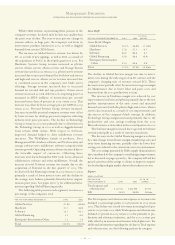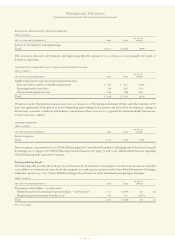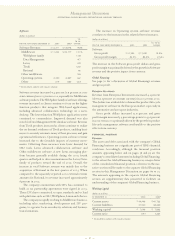IBM 2003 Annual Report Download - page 49
Download and view the complete annual report
Please find page 49 of the 2003 IBM annual report below. You can navigate through the pages in the report by either clicking on the pages listed below, or by using the keyword search tool below to find specific information within the annual report.
the client’s premises or managed remotely at IBM’s own
facilities—and consulting about how to improve and
strengthen the infrastructure and realize greater return on
investment in it. Central to IBM’s approach for building value
in the infrastructure category is its support of open standards
and its active promotion of Linux, the open source operating
system, which helps IBM’s clients control costs and allows
them to benefit from the latest developments created by the
Linux development community around the world. To support
Linux development and deployment, IBM has enabled its
servers and storage products to operate with Linux, IBM’s
leading middleware products are designed to work in a Linux
environment, and Linux is a preferred choice for many of the
company’s services and consulting engagements.
strategy
Deliver open and integrated offerings; expand partnerships;
continue to exit select markets, such as application software.
capabilities
Application Management Services – Application development,
management, maintenance and support services for pack-
aged software, as well as custom and legacy applications.
(Global Services)
Commercial financing – Short-term inventory and accounts
receivable financing to dealers and remarketers of IT prod-
ucts. (Global Financing)
DB2information management software – Advanced database
and content management software solutions that enable
clients to leverage information on demand. (Software)
e-business Hosting Services – Solutions for the management of
clients’ Web-based infrastructure and business applications,
as well as a growing portfolio of industry-specific independent
software vendor (ISV) solutions that are delivered as a service.
(Global Services)
Integrated Technology Services (ITS) – Design, implementation
and maintenance of clients’ technology infrastructures.
(Global Services)
Lotus software – Collaboration and messaging software that
allows a company’s employees, clients, vendors and partners
to engage in real-time and asynchronous communication and
knowledge management. (Software)
Personal computers – Desktop and notebook computers featur-
ing ThinkVantage technologies that provide enterprises and
end users with increased productivity and cost-effectiveness.
(Personal Systems Group)
Printing Systems – Production print solutions, on demand
print-related solutions, enterprise workgroup print technolo-
gies, and print management software and services. (Personal
Systems Group)
Rational software – Integrated tools designed to improve an
organization’s software development processes and capabili-
ties. (Software)
Remarketing – The sale and lease of used equipment (primarily
sourced from the conclusion of lease transactions) to new or
existing clients. (Global Financing)
Retail Store Solutions – Point-of-sale retail checkout equip-
ment, software and solutions. (Personal Systems Group)
Servers – IBM eServer systems using IBM operating systems
(zSeries and iSeries), as well as AIX, the IBM UNIX operat-
ing system (pSeries) and the Microsoft Windows operating
system (xSeries). All servers can also run Linux, a key open-
source operating system. (Systems Group and Software).
Storage – Data storage products, including disk, tape and
storage area networks. IBM continues to be a leading vendor
in storage services. (System Group)
Strategic Outsourcing Services – Competitive cost advantages
through the outsourcing of processes and operations.
(Global Services)
Tivoli software – Software for infrastructure management,
including security, change, configuration, job scheduling,
storage capability, performance and availability. (Software)
WebSphere software – Management of a wide variety of business
processes using open standards to interconnect applications,
data and operating systems. (Software)
Component Value
overview
Component Value describes advanced semiconductor devel-
opment and manufacturing for IBM’s server and storage
offerings, and services, technology and licenses provided to
OEMs that create and market products requiring advanced
chips and other core technology elements.
strategy
Leverage components for Infrastructure Value; and continue
to participate in select markets and to pursue outsourcing
for manufacturing of select products.
capabilities
Application Specific Integrated Circuit (ASICs)–
Manufacturing
of customized semiconductor products for clients.
(Technology Group)
Advanced Foundry – Full suite of semiconductor manufactur-
ing and integrated supply chain services using either a
client’s or IBM’s design. (Technology Group)
Standard products and custom microprocessors – Semiconductors
designed and manufactured primarily based upon IBM’s
PowerPC architecture. (Technology Group)
Management Discussion
INTERNATIONAL BUSINESS MACHINES CORPORATION AND SUBSIDIARY COMPANIES
47




